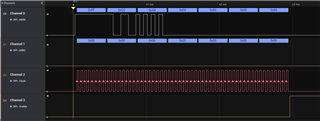Hi Team,
We are using EK-TM4C1294XL board to send 24 bit data to our Ethernet switch via SPI and we have to read back 32 bit data from the switch.
Queries:
1) After sending 24 bit data via SPI we are not able to read back 32 bit data, instead 24 bit data only coming.
Our requirement is to send 24 bit data and read back 32 bit data continuously, i.e. we need to generate 56 clock pulse continuously. Is there any way to generate 56 clock continuously.
Please see the image attached below.

the above mentioned image is our requirement.
We tried to capture the data transmission in oscilloscope but we are receiving 24 clock pulse alone. i.e. we are not getting the clock continuously.
2) We have tried to with two EK-TM4C1294XL board for the same purpose. The master Tiva board will send 24 bit data to the slave board and the slave board will send 32 bit data back to the master board
and in master board we will read the 32 bit data and print the data in serial monitor. But we are receiving 24 bit data only.
3) In SSIConfigSetExpClk() API there are 6 modes of frame format are there. We have tried to use different frame format for sending data via SPI but we are not able to get the desired result.
Can you suggest which frame format will be more suitable for our application.
Thanks and regards,
Abishake Sivasanmugam


